Thursday, March 31, 2005
Food for Thought: Half Baked
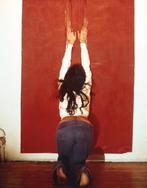 In this issue Kathy O’Dell covers the traveling Ana Mendieta exhibition. In her review of the show, O’Dell comes close to saying in print what many who have seen the show are saying quietly in private—that Mendieta’s work lost its strength and edge after she split with her teacher and lover Hans Breder. O’Dell, though, does not go that far.
In this issue Kathy O’Dell covers the traveling Ana Mendieta exhibition. In her review of the show, O’Dell comes close to saying in print what many who have seen the show are saying quietly in private—that Mendieta’s work lost its strength and edge after she split with her teacher and lover Hans Breder. O’Dell, though, does not go that far. She raises the issue obliquely, without ever mentioning Mendieta and Breder’s personal relationship. Mendieta’s late work, O’Dell rightly claims, is weak—very weak. Almost half of the period covered by the show she points out (amounting to a third of the work on display) is time that Mendieta spent in Iowa working with Breder. This early student work is actually the best work in her oeuvre. O’Dell leaves it up to her readers to connect the dots.
Since the exhibition first brought together works from across Mendieta’s short life at the Whitney last summer, people have been whispering about the notable fall-off in the quality of her work after she and Breder ended their relationship. No one that I have seen, though, has been willing to open themselves up to the drubbing that will inevitably come from more vocal feminist critics and the goddess crowd if they say this publicly.
It’s a shame that critics and reviewers have felt it necessary to self-censor on this obvious point. All seem to be operating within the confines of the Romantic notion of the artist as a solitary individual creator. If they would be willing to open up their notions of artistic production to explore the nature of collaboration (and to examine how Mendieta fueled Breder’s work as much as he charged hers), Mendieta’s reputation would be enhanced. As the situation stands now, she is being publicly lionized but privately denigrated. That disingenuousness doesn’t serve her reputation, or viewers interested in seeing the show, well.
Tuesday, March 29, 2005
Why Human Translators Aren't Going out of Style
Case in point: here's something that must have been translated by machine without human intervention. This blurb comes from a bilingual English-Spanish map I picked up at my hotel today. Here's what's printed on the map in English (reproduced exactly as it appears) right below a poetic Spanish-language description of Gaudi's Sagrada Familia:
Even though it is a grand expiatory temple, The Sacred Family are two peaks on the line of the horizon, some reproductions made out of chocolate for Easter, are postcards as a memento, the scenery of concerts, the inspirations of musicians such as Alan Parson, of sculptors like Subirachs, of movies like Glory Day and of an infinite or newspaper articles and news items on TV and more than 70 books. 4.000 people a day visit the Sacred Family. It is a phenomenon of multitudes and a lively and mutant monument.Why go with the much more conservative "living and changing monument" when you can transliterate the cathedral into something lively and mutant. It's much more dramatic that way.
Monday, March 28, 2005
Quiet Week
I do, though, have something about bug zappers in the hopper that I may finish off on the flight. Stay tuned. Zap!
Best of New York 2004
I understood what she meant, but I didn’t realize how perfectly her comment encapsulated the show until I saw it for myself this weekend.
For an exhibition intended to present the current state of the art in this state of the arts, it accomplishes its objective well. Any time work by a group of 160 emerging artists is brought together, viewers should expect a great amount of variability. Greater New York reduces the beta between the best and the worst to an order of magnitude less than what gallery goers wandering Chelsea, the East Village, and Williamsburg will experience on any given weekend.
For such a competent editorial job, we can be grateful to the team of P.S.1 and MoMA curators. They’ve spent months separating the wheat from the chaff, assembling a large show of quality work by young New York artists that presents a positive, upbeat view into the practice of artistic production in the area today.
That said, the show is missing the edge of experimentation, of artists flying without a safety net as they try out new ideas or approaches. As a result, the exhibition has the feel of a best-of-the-year awards show for work already seen in other venues.
Given other commitments, I don’t see as much art as I would like to. I miss more than I actually see. I was surprised, then, by just how much of the work on display in Greater New York I had already seen in other venues over the last year. While walking the gallery floors I started to make a mental list of what I had seen and where I had seen it:
- ATM Gallery: Peter Caine and Min Kim
- Momenta Art: Pawel Wojtasik
- Bellwether: Kristen Hassenfeld and Tanyth Berkeley
- Artnet: Steve Mumford
- LFL: Phoebe Washburn
- The Armory Show 2004: The Atlas Group/Walid Raad
- Whitney: Ryan McGinley
- Whitney Altria: Wangechi Mutu, Matthew Day Jackson, and Marc Swanson
- Art Rock: Marc Swanson and Rob Fischer
- Whitney Biennial 2004: Banks Violette, Sue De Beer, Cory Archangel, Christian Holstad, Amy Cutler, and Rob Fischer
- Open House: Working in Brooklyn: Amy Cutler and Rob Fischer
- Leslie Tonkonow: Amy Cutler
Greater New York 2005 feels very much like the Whitney Biennial meets Open House: Working in Brooklyn with an age limit of 35 for contributors. It’s a mega-show filled with the easiest, most non-offensive pieces available by many artists whose work we’ve seen before (often in several places).
All in all, Greater New York 2005 is a good show that is worth seeing. It’s a very capably edited show. It’s a correct show. But there’s not much risk taking going on. We wouldn’t expect anything else from today’s MoMA, though, would we?
Greater New York 2005 (through September 26, 2005) at P.S. 1.
Friday, March 25, 2005
Another PR Win (of Sorts) for MoMA?
But MoMA's press flacks are incredibly effective in working quietly through back channels as well. We've heard rumors about how they have an amazing ability to find just the right lever to pull with a journalist's editor or publisher to get a story killed before it runs.
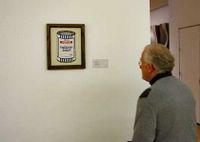 Since Wednesday's Wooster Collective exclusive, the art world has been snickering to itself about Banksy's recent New York excursion. Seeing coverage of the story in yesterday's Times made me wonder if MoMA had been at work behind the scenes again to limit its press exposure related to Banksy's work in their galleries.
Since Wednesday's Wooster Collective exclusive, the art world has been snickering to itself about Banksy's recent New York excursion. Seeing coverage of the story in yesterday's Times made me wonder if MoMA had been at work behind the scenes again to limit its press exposure related to Banksy's work in their galleries.What makes me wonder this is the fact that in its coverage of the story and the accompanying on-line slide show, the Times ran all the images from Wooster except the two images of the Tesco soup can at MoMA (one of which is at right). Run the whole lot of photos available except for two? And those two just happen to both be from MoMA? You have to wonder.
Related:
- Transcript of Banksy's e-mail interview with the Times: "It's harder to paint subway trains in New York these days than it is to paint your major public exhibition spaces."
- Reuters coverage of the story: "I tend to gravitate to places with less sophisticated security systems."
Thursday, March 24, 2005
Explicate This, Sucker
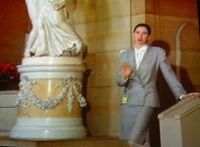 The only thing we love more than docents is poking fun at docents. That's why we're big fans of Andrea Fraser's performances as Ms. Jane Castleton. Her formal readings of art museum drinking fountains raise the bar on all public education activities.
The only thing we love more than docents is poking fun at docents. That's why we're big fans of Andrea Fraser's performances as Ms. Jane Castleton. Her formal readings of art museum drinking fountains raise the bar on all public education activities.Given that background, I was pleased to see this announcement come across my desk yesterday. Next week the Sheldon in Lincoln, NE, is giving visitors the chance to compete for the title of world's worst (or best, depending on how you view it) docent. Here are the details:
Ever wonder where the stories behind the art come from? Think you could spin a better tale? Then come ready to put your creative talent to good use and join the Sheldon Memorial Art Gallery on Friday April 1, 2005 for its monthly first Friday event. We're hosting a contest for the most creative and humorous interpretation of a piece of artwork to align with our April Fool’s theme. The event is from 5:00 –7:00 p.m. We will be accepting contest entries until 6:30 p.m. with the prize being awarded at 6:50 p.m. We hope to see you here!Hope to see you there indeed. For once I'm sorry that I'm not going to be in Lincoln next week.
Wednesday, March 23, 2005
de Kooning Wins National Book Critics Circle Award
 This news is slightly dated by now, but I somehow managed to avoid hearing it until last night.
This news is slightly dated by now, but I somehow managed to avoid hearing it until last night.Mark Stevens and Annalyn Swan have been awarded this year's National Book Critics Circle Award in the biography/autobiography category for de Kooning: An American Master.
Related:
- de Kooning: An American Master, publisher's website
- National Book Critics Circle award citation for de Kooning
- All 2004 winners; all finalists
- Modern Kicks on the book; Studio Notebook on the book
- Modern Kicks as Knopf's new corrections service (read through to the end of the comments)
Tuesday, March 22, 2005
Foer and Sugimoto and Serra, Oh My!
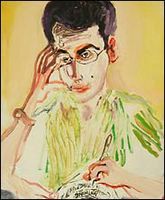 Last night Jonathan Safran Foer hosted a salon cum book discussion at the Upper East Side home of a New York Public Library supporter. While the planned scope of discussion was limited to his new novel, Extremely Loud and Incredibly Close, Foer veered off topic several times and revealed something buried so deeply in his psyche that he managed to keep it hidden in that painfully precious Times Magazine profile from a few weeks ago: Foer has visual artist envy.
Last night Jonathan Safran Foer hosted a salon cum book discussion at the Upper East Side home of a New York Public Library supporter. While the planned scope of discussion was limited to his new novel, Extremely Loud and Incredibly Close, Foer veered off topic several times and revealed something buried so deeply in his psyche that he managed to keep it hidden in that painfully precious Times Magazine profile from a few weeks ago: Foer has visual artist envy.At various points during the evening, Foer admitted the following:
- He prefers going to galleries over reading other novelists’ work
- He’s been spending time looking at MoMA’s collection of artists’ books and mulling over how he could get some of that action
- He’s more interested in expressing ideas than in staying true to the novel as literary form; the use of creative typography and photography in his new book allowed him to work in a non-linguistic manner
- He occasionally asks himself why he’s not a visual artist and tells himself that he could be if he really wanted to
One thing he didn’t admit: stealing Glenn Ligon’s shtick a couple times in Extremely Loud and Incredibly Close by compressing the type as it runs down the page, rendering it illegible by the bottom.
Foer also mentioned a project he has in progress that promises to be even more idiosyncratic than anything he has done to date. He is collaborating on a book with Hiroshi Sugimoto. Foer is writing the text for a collection of Sugimoto photos of Richard Serra sculptures. The target audience for this book, I guess, is people who can’t hop Metro North to Beacon to see the real things for themselves.
How did Foer get brought into this project? When he was an undergrad, before he was known as a writer, someone gave him a book of Sugimoto’s photographs. He wrote Sugimoto a fan letter, and the two developed a friendship. They’re now so tight that Foer and his wife spent their month-long honeymoon traveling around Japan with Sugimoto. I hope for the sake of Foer’s marriage that his wife likes (no, loves) wax museums and plaster stereometric models as much as he and Hiroshi do.
Related:
- Extremely Loud and Incredibly Close, publisher’s website
- Hiroshi Sugimoto’s Mathematical Forms
- Michiko Kakutani’s review of Foer’s new book in today’s NY Times: “an admirably purposeful but ultimately mannered and irritating novel”
- Deborah Solomon’s portrait of the artist as a fey young man
Sunday, March 20, 2005
News Flash / Shopping Alert
NY Times: "The Barest Luxury as a Necessity."
Friday, March 18, 2005
Bootlegging the Bootlegger, Anyone?
 A few weeks ago, on my usual Sunday afternoon stroll, I came across an intriguing group of sculptures at Animal in the East Village.
A few weeks ago, on my usual Sunday afternoon stroll, I came across an intriguing group of sculptures at Animal in the East Village.Each work in the Contraband series is a shrink-wrapped plastic bottle containing one object that is illegal to sell, own, use, or transport. The image at right is of $100 in counterfeit U.S. currency. Other items in the series include human remains, lock picking tools, brass knuckles, telephone wiretap equipment, two ounces of moonshine, elephant ivory, and child pornography.
The art tests the limits of the law, exposing its owners and distributors to the possibility of legal action. Existing in a legal gray zone, the work is edgy and challenging in a way that has real consequences.
My interest piqued, I inquired about the cost. At $1000 each, though, my desire to own a couple pieces waned quickly.
The series is by the artist Eric Doeringer, better known for his bootlegs of work by other artists—technically impressive, miniature replicas of well-known pieces that he sells for relative pocket change. (James Wagner has great images of his latest bootleg—a Maurizio Cattelan.) I'm going to be keeping my eyes open. If I ever come across bootlegs of Doeringer’s Contraband series, I’ll jump in for a few.
Thursday, March 17, 2005
Limits to Accessibility and the Art Market’s Value Chain
The concept of the value chain is defined like this: “The value chain categorizes the generic value-adding activities of an organization. The ‘primary activities’ include: inbound logistics, production, outbound logistics, sales and marketing, maintenance.”
Granted, the creation of fine art differs from the manufacture of widgets, but the framework still provides an interesting way of looking at market dynamics. The mapping between links along the value chain and art market functions is completely straightforward:
- Inbound logistics: the purchase and receipt of art supplies
- Production: the creation of art work
- Outbound logistics: contracting and delivery of finished product to the distributor (i.e., the gallery)
- Sales and marketing: all gallery activities
- Maintenance: framing and conservation
When undue pressure gets exerted on one link, ripples of impact are typically felt up and down the value chain. In details that came out in the recent lawsuit and judgment against The Project, we’ve seen how the sales and marketing link in the chain has become seriously stressed. The correlation between the supply of quality, desirable, high value product and the demand for it is so unbalanced that the normal principles of free market economics no longer hold at this point on the chain.
It’s clear to anyone who follows the art world that this aberration from the norm is causing stress up the chain. Gallerists have taken a strategy from NBA teams. They are drafting students who are still in school and are launching them into the major league earlier than ever. Columbia and Hunter open studio events, for example, are mobbed by hungry dealers and collectors looking to identify the next new thing. Students are getting solo shows before they finish their degree programs or immediately after.
The pressure on artists to be discovered early is, in turn, stressing the production link in the chain. Work today is being made fast and released early. Much of what’s being shown in smaller New York galleries has the feel of student work—what would, until a few years ago, never have been shown outside an MFA exhibition.
These dynamics have been noted elsewhere. People who follow the market are well aware of them.
Yesterday, though, I got my first indication that ripples of impact are being felt down the chain as well.
In the past I’ve worked with an excellent framer who specializes in fine art work. I found him five or six years ago when I bought my first piece of art—a print from a 57th St. dealer. The gallerist asked me if I wanted to have the artist’s framer frame the piece for me. When I said that I did, she replied in a tone implying a value judgment, “OK, but you’ll have to make arrangements to have the work delivered to you when it’s ready. The framer is waaaay downtown.”
His studio, it turns out, is two blocks from my apartment.
This week I bought a couple drawings that need to be framed. Yesterday I happened to walk by the framer’s building, so I stopped and rang his buzzer to ask when I could drop them off. I was surprised when he told me that he’s not doing retail work anymore. He’s too busy, he said.
Being slightly shocked, I found myself starting to do the dance more typically done for a gallerist showing work by a desirable artist. “But I’ve given you business in the past. I’ve even given you referrals. You’re the best around. You do such great work that I can’t imagine going anywhere else. Can’t you please make an exception for me and let me buy your services. Please? Please? Please?”
Finally, he relented. But he required me to schedule an appointment to drop the work off at an inconvenient time in the middle of the day. The wife brought the work to him today. He was nice enough, she said, but the best date he could estimate for delivery is a little over three weeks away—and even that isn’t a firm commitment. The art market has gotten so active now that unless you’re someone special it’s difficult to get a master framer to do work for you.
There’s now only one unstrained link left on the chain: inbound logistics. What does this say to the business strategist in me? Either the whole chain is about to blow apart, or it’s just a matter of time until demand exceeds supply at that point as well.
Assuming that we’re not going to see a disruptive production and distribution model emerge in the next two years and that the market isn’t going to undergo a radical correction, it’s prime time, folks, to get into the art supplies business. There’s going to be serious money to be made there soon. You heard it here first.
Wednesday, March 16, 2005
You Do the Math
Here are the inputs:
- Artnet reports that tuition for SVA's new MFA program in art criticism is set at $11,000 a semester.
- SVA requires students to be in residence for four semesters before it will award the degree.
- Realistically, what career options does the degree open for graduates?
Here's how the numbers come together for me:
- Estimated tuition for an MFA in art criticism from SVA: $44,000.
- Dooming yourself to a lifetime of hustling from one freelance gig to another: priceless.
Tuesday, March 15, 2005
Job Posting of the Day
Become alienated from your labor by making art on an hourly basis for someone who will eventually sell it for seven figures!Isn't capitalism a wonderful, wonderful thing?
Monday, March 14, 2005
One of These Things Is Not Like the Other
Your assignment for tomorrow: compare and contrast the commercial empires created by Damien Hirst and Thomas Kinkade (password).
Saturday, March 12, 2005
The Armory Show 2005
In which our hero gets his ass thoroughly kicked by one eight-pound human (who had not slept well the night before), two piers jutting out most impressively into a river (named, it is said, after an explorer set adrift by a mutinous crew to die in a snowy bay), and many galleries (162 to be precise) from various continents showing work of diverse types (some requiring electricity).Someone shared a cautionary tale with me this week about mixing a three-week-old child with the Armory Show. I didn’t listen. As a result, I now have my own cautionary tale to tell.
Let’s just say this. I don’t remember much of what I saw on the first pier, and I’m fairly certain I sleepwalked my way through the second. I am carrying a vague memory of a strobe lit sleeping bag for a whale. I think this was something I saw at Daniel Reich’s booth, but I can’t be certain that I didn’t dream it.
As I was wandering the floor, seeing scads of interesting work on paper, I had what felt like a great idea. What would it look like if someone went on a spending spree, bought tons of drawing really quickly, and put together a state-of-the-moment view into the practice? Brilliant, important, a big deal.
When I woke up with a clear head later this afternoon after a three-hour nap, I realized that someone else had this idea already—exactly two years ago.
The Armory Show (through Monday, March 15). See it before it closes. And then tell me what I saw, but missed.
Friday, March 11, 2005
Scope: It Doesn't Suck!
While it's official policy at From the Floor never to say anything nice about the west coast (especially LA...), I do have to admit that I was impressed by what dealers from the other coast had brought with them. LA's Acuna-Hansen, for one, had an especially large amount of quality work to offer.
In addition to everything one might expect to see from a pack of gallerists showing work by mostly emerging artists (read: small, obsessively detailed, figurative works on paper), there were several other trends on display:
- Bedspread art is big this season (for obvious reasons at Scope), while textiles in general make a strong appearance.
- Cut up currency (dollars and pesos) shows up in more places than you would imagine.
- How many artists today are finding inspiration in shopping carts? More than you would guess.
- Diasec has now officially moved down-market. Face-mounted photographs are no longer solely the purview of Germans working in large format at five and six figure price points.
In general, there's much more painting on display this year (and, commensurately, less video and installation) than at past Scope fairs. I'm not sure how I feel about that (and the whole return to painting, in general), but on the whole this year's Scope doesn't disappoint like it has in the past.
Thursday, March 10, 2005
Notes on Demand
 Some notes clipped pretty much verbatim from the notebook I was using as I wandered the Thomas Demand show at MoMA last Sunday.
Some notes clipped pretty much verbatim from the notebook I was using as I wandered the Thomas Demand show at MoMA last Sunday. - The work has a hard time standing on its own. It needs to be propped up with something. Here’s one show that would actually benefit from more wall text.
- Could one make an argument that Demand has created a new form of abstraction? While his work contains recognizable objects, it’s not representational because viewers can’t punch through to the objects’ referents without having additional information that doesn’t exist within the work itself. If, historically, abstraction was a reduction of artistic practice to form, materials, and process, Demand could be called an abstractionist.
- Because the technology is still relatively new, large face-mounted photographs seduce people. The medium tends to get off the critical hook too easily.
- The work removes us too far from the real world of explosions and cooking and dappled forest sunlight without really providing us a reward for undergoing the process of removal. Maybe this is a stretch, but Brecht did something similar for the theater with his “alienation effect.” He removed the audience’s ability to relate or sympathize with any character from his drama. The power of a Brecht play comes from this removal of a natural part of the theater-going experience. The experience of viewing Demand’s work, though, is not heightened by or dependent on the removal from reality upon which he bases his work.
- A fun assignment: calculate how many layers of remove from reality there are in any one of his photographs.
- How does Demand compare to the other young Germans? Gursky gets daily life in all its complexity at a precise moment in time. Hoffer gets built and ornamented space. What does Demand get?
- Demand makes art for people who like the idea of art, not art as idea.

Thomas Demand (at MoMA) runs through May 30, 2005.
What's Sitting in My Inbox Today
- The first issue of the relaunched Artkrush.
- This week's issue of NYFA Current.
- Email from the developer of a great new application called MyBlogLog. If you blog, you'll want to check this out.
- A ton of e-Flux press releases.
- An email from another blogger saying that he got credentialed for the Armory Show's press preview, but that P.S.1 isn't letting bloggers attend the Saturday press preview for Greater New York. They said it's for broadcast media only. When is The Times getting in, I wonder.
- Last week's issue of The Art Newspaper's newsletter.
- A notice that the editor of my favorite photoblog, Eliot Shepard of Slower, has an exhibition opening at Jen Bekman on March 22.
Wednesday, March 09, 2005
Watching Evolution in Progress
I've written in the past about how we are seeing more transparency in the art market as time progresses. Obviously though, as Salmon so capably points out, one couldn't yet call it a rational or fully transparent market.
While I can somewhat understand why dealers at the very top end of the market would think that they can and should engage in the sorts of practices that Salmon describes, it continues to astound me that dealers specializing in works at much, much lower price points think they can do so as well.
Case in point: a few weeks ago I was in a Chelsea gallery looking at work in an outstanding group show. I was interested enough in two unsold pieces to consider a purchase. I asked the gentleman working the desk for a price list, and he replied coldly that they didn't have one. I would need to talk to someone for that information. That sort of attitude and approach raises my hackles--and not just a little bit. I left the gallery, in effect deciding against purchasing either work. I'll bet these two young artists will never know that their dealer's practice cost them my sale. I wonder how many others they have lost in the same way.
As collectors are empowered by having access to information, they will continue to demand more straightforward treatment during the purchasing process. Some gallerists have realized and embraced this trend. They will continue to see better sales--surviving as the most fit of their species when the market begins to soften, as it surely must. Those that resist change in a new environment will be the first to become obsolete.
It's not often that laypersons have the chance to view evolution in progress. Followers of the art market have that opportunity today.
Update: For collectors aspiring to game the system this week by sneaking into the Armory show early, The Observer gives all the tricks you'll need to know.
Monday, March 07, 2005
Expecting More, Demanding Less
I had a short list of exhibitions to see this weekend before New York gets overrun with art fairs and interesting museum shows later this month. Alas, the new little body in the apartment (and a number of big bodies traipsing through to see it) kept me homebound. Guess I've got to learn to be a little less demanding of myself for the next couple months.
Speaking of demand, though, I did get out for an hour yesterday to see the Thomas Demand exhibition at MoMA. (You've got to know that a blogger can't write about this show without using a lame pun somewhere.) Demand's work has always left me cold, but I promised myself to look with a fresh eye last Friday after seeing Michael Kimmelman wet himself over the show and after hearing Greg chime in with a modest "amen." I thought that seeing a larger body of work would give me more insight into Demand's practice than the individual pieces I have seen here and there.
Not so. Piece after piece, the show presents work that is cold, flat, and executed at such a remove from reality that it left me asking "so what?" Kimmelman goes on and on, getting all worked up, about the layers of referentiality in Demand's photographs. Sure, the referentiality is there, but I don't think the work itself manages to use this to its advantage. It takes something extra--some kind of "zing" or "pow"--for work that exists to show how it fits within a tradition to hold my interest. Demand's just doesn't have that.
I'm planning to pull my impressions together and write something more formal for later this week. Stay tuned.
One interesting note (and there always is one, isn't there?) from yesterday's MoMA visit. I saw Ronald Lauder, chairman of MoMA's board of trustees, hanging out in the contemporary galleries. He wasn't really looking at the art. He was just wandering between galleries, watching the visitors look at the art. He wasn't wearing the polyester prophylactic, but it sure did look like he was on guard duty. What's up here? Does MoMA have a new service requirement for its board, and is Lauder leading by example? If board members are being expected to take a turn on the floor, they shouldn't demand less.
Thursday, March 03, 2005
The Flavin Mix
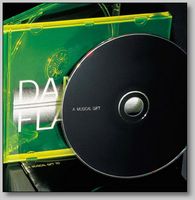 Like every other global investment firm, Deutsche Bank makes markets in weird stuff. I know this first hand. A couple years ago, I did a project for a business unit of theirs that trades the weather.
Like every other global investment firm, Deutsche Bank makes markets in weird stuff. I know this first hand. A couple years ago, I did a project for a business unit of theirs that trades the weather.But today I came across something Deutsche Bank is selling that I'll bet none of their competitors are: a genuine Dan Flavin mix tape. Here are the details:
In 1993, the extension to the Städel-Museum in Frankfurt opened with an exhibition of Dan Flavin’s work. The artist organised the evening of the opening so that he would enjoy it as much as possible. Flavin had a cassette of songs sung by Richard Tauber play continuously throughout the evening. Romantic tones blended with the rooms flooded with colour to create a poetic experience. The CD includes Richard Tauber’s interpretation of “Dein ist mein ganzes Herz”, which the artist is known to have considered a favorite of his, along with remixes of this piece by Antonelli Electr and Elektro Music Department.Burned to CD and hand numbered in an edition of 1000, Flavin's favorites can be yours for only €12.50--or approximately $125 at the current Euro to Dollar exchange rate.
Wednesday, March 02, 2005
Not Coming Soon to a Museum Cafe Near You
Cafe Sabarsky seriously raised the bar on museum cuisine a couple years ago, turning the Neue Galerie into a destination for German-Austrian food. Not wanting to play second fiddle to anyone, MoMA made sure it had restaurant-quality meals (at restaurant-quality prices) as it planned its reopening. Even The Met is playing along with its new basement cafeteria. They don't have table service, but the food there is still better than what's on offer in most cities I have to visit for the day job.
So with the trend toward quality eats firmly established, I think it's safe to say that we won't be seeing any of these things being served at New York museums anytime soon. Too bad. The chilled celery log looks like a winner.
Tuesday, March 01, 2005
Untitled Projects on eBay
Bakker crafts handmade objects that resemble consumer products and then releases them into the world through distribution channels more frequently used for commodities than art: retail stores, mail order catalogues, a multilevel marketing system, and yard sales.
Bakker’s newest project, launching today, makes use of the online auction and gives eBay shoppers the chance to purchase interesting pieces of art for small change. This paragraph comes from today’s auction:
Every day during the month of March and April, a painting based upon an eBay auction photograph of a postcard that was sold from Indiana will be put up for a three-day auction on eBay in the postcard category. The painted reproductions are sized and priced according to the original eBay images and auctions (approx. 4 1/4 x 5 1/2 inches). As the paintings/postcards are sold, they will be shipped from the Peeler Art Center at DePauw University to the highest bidder as a genuine souvenir from Indiana.
Here’s the first item up for bid: a 1980s color postcard of the Staten Island Ferry and the Statue of Liberty.
Good luck, and happy bidding. Just don’t outbid me on the one I really want.